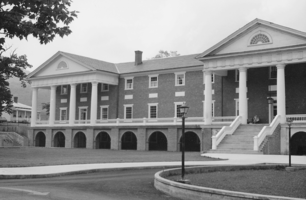
Sweet Springs, located on State Route 3 in eastern Monroe County, is the site of a historic mineral spring resort in use since the late 1700s. The spring water, which emerges from the ground at 73 degrees F., contains a concentration of iron and carbon dioxide and has been credited with medicinal properties.
The resort at Sweet Springs was known as Old Sweet Springs or simply “Old Sweet” for its long history. The first hotel was erected in 1792 by William Lewis who first developed a resort around the spring. William Lewis was a Revolutionary War veteran and the brother of General Andrew Lewis, who commanded Virginia militia at the Battle of Point Pleasant, and of Charles Lewis, who died in that battle. From 1795 to 1807, a Virginia district court representing the counties of Botetourt, Greenbrier, Kanawha, and Montgomery met at the Sweet Springs resort.
The heyday of the resort was from 1820 until the Civil War. In the 1830s, the present large brick hotel was constructed with columned porticos. Its design was long attributed to Thomas Jefferson but more recently has been accredited to a Jefferson associate. A second large building and five cottages were erected in 1857. Sweet Springs, during this period, was a day’s carriage drive from eight other mineral spring resorts in what was termed the ‘‘Springs Region’’ of pre-Civil War Virginia. Guests would frequently make a circuit of several mineral springs resorts during the busy summer season sampling the water and social life at each. Famous visitors to Sweet Springs included George and Martha Washington, General Lafayette, Chief Justice John Marshall, Jerome Bonaparte, Patrick Henry, James and Dolley Madison, and Robert E. Lee. Presidents Pierce and Fillmore also visited the resort.
In June 1864, the resort was visited by Union forces under the command of Gen. David Hunter. His troops camped in the vicinity of the resort, but there is no record that the buildings were harmed. Sweet Springs continued to attract guests after the Civil War, but many potential visitors preferred to go to resorts that were more convenient to the rail lines.
Old Sweet was operated by William Lewis, and in turn his son and grandson, until 1852, when the financially distressed property was acquired by Allen T. Caperton and Oliver Bierne of nearby Union. It came back into the hands of the Lewis family from 1902 to 1920 and operated under a succession of owners until it went into receivership in 1930.
In 1945 the state of West Virginia purchased the property and established the Andrew S. Rowan Memorial Home for the aged in the old resort’s buildings. It was added to the National Register of Historic Places in 1970. A major renovation was undertaken from 1972 to 1975. The Rowan Home was closed in 1991, and the state turned the facility over to Monroe County to establish a rehabilitation center for drug addicts. This project failed, and in 1996 the former resort was sold into private hands. In 2005, Sweet Springs was sold again, and the new owner hoped to restore the resort to its former glory. However, on November 12, 2015, the resort was auctioned to Ashby Berkley, along with equipment and facilities to bottle the famous Sweet Springs mineral water, for $560,000.
Read the National Register nomination.
This Article was written by Michael M. Meador
Last Revised on June 23, 2022
Related Articles
Sources
Cohen, Stan. Historic Springs of the Virginias. Charleston: Pictorial Histories Publishing Company, 1981.
Morton, Oren F. A History of Monroe County. Staunton, VA: McClure, 1916, Reprint, Regional Pub. Co., 1974.
McColloch, Jane S. Springs of West Virginia. Morgantown: West Virginia Geological & Economic Survey, 1986.
Johnson, Rody. A Lewis Family Legacy: Old Sweet Springs. Goldenseal, (Summer 2000).
Cite This Article
Meador, Michael M. "Sweet Springs." e-WV: The West Virginia Encyclopedia. 23 June 2022. Web. 26 July 2024.


Comments?
So far, this article has 1 comment.
Click here to read and contribute to the discussion →